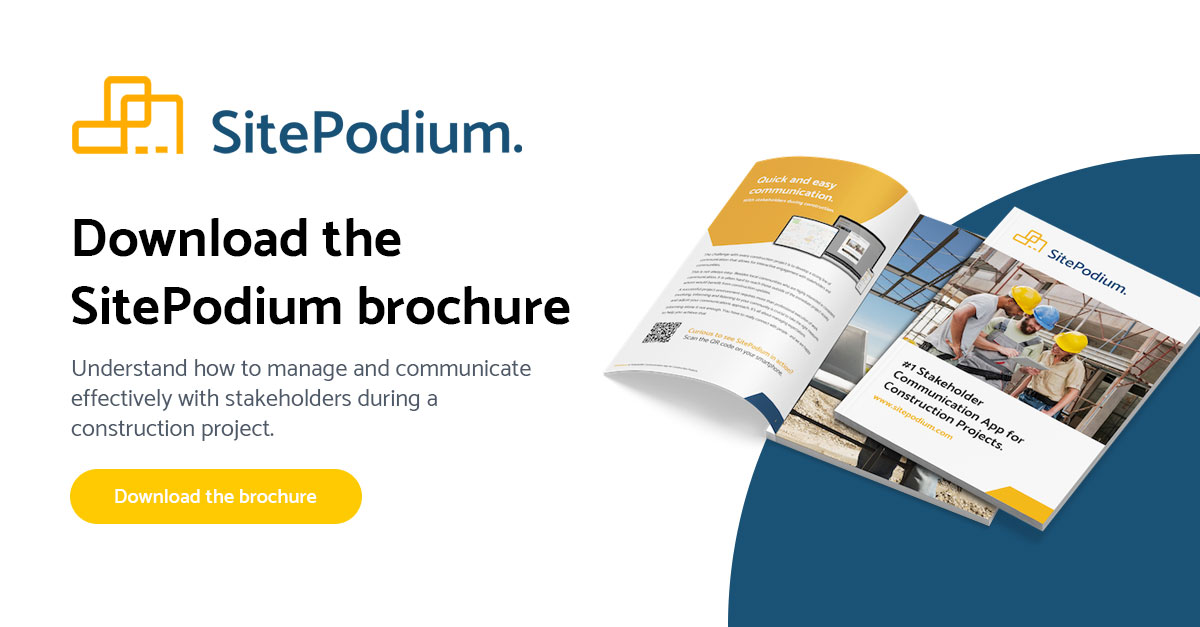Stakeholder management in construction projects consists of a series of procedures. You first identify, then prioritise and finally engage your stakeholders. Every stakeholder requires a different approach and that makes stakeholder management in construction projects a complicated task.
Too often, the importance and weight of this task is underestimated. Direct stakeholders, like clients, contractors and suppliers, generally get much more attention than indirect stakeholders, such as local residents and shop owners or (political) interest groups.
Effectively managing the stakeholders in your construction project means including all the parties involved, even if they do not directly contribute to its progress.
At SitePodium, proper stakeholder management is at the forefront of what we do every day. In our previous blogs we spoke at length about the different stakeholders in construction projects and engaging them. We now share our 5 golden tips on how to do this effectively.

1. Stakeholder mapping (and repeating this regularly) is a must
You cannot manage your stakeholders properly without first creating a stakeholder map. You make a complete summary of all your stakeholders and the degree of influence they have on your project. In your map you include the risk they impose on your project and the part they play in it.
Stakeholder mapping is firstly identifying all your stakeholders and secondly prioritising them. The result is a visual representation of every party that influences your project in some way. It shows their relationship to each other and to you. Stakeholder maps often look a lot like flow charts.
Once you have made your stakeholder map, you regularly revisit it. There can be changes; new stakeholders might have emerged maybe there are stakeholders that have left. The priority they get in your map may also change, as well as the risk they impose on your project. This visual tool is the basis for all the stakeholder management activities in your construction project.
2. Be transparent
Secondly, and this is also essential, you cannot do proper stakeholder management in a construction project if you are not honest. Transparency will be appreciated so much more than secrecy by every single one of your stakeholders. As you are managing your stakeholders you will also have to announce events that might influence some of them negatively.
Instead of trying to make it nicer than it is, you tell them exactly what you are doing when, why, and how this will influence the stakeholder in question. It is crucial here that you also make it clear that you are doing everything to make this as easy as possible for them.
To explain this further, we will take a practical example. You are planning construction work on site that will cause noise and possibly some pollution. This will influence the local residents negatively, as their daily lives will be disturbed by noise and dust.
- You tell them what is scheduled and when: your local residents will get annoyed by the bad news, but they realise that there is still time to make arrangements for what will happen.
- You tell them why you are doing it: they understand the reasoning behind what you are organising and are more willing to accept the disturbance.
- You tell them what you will do to make it easier for them: they will feel noticed, like their wellbeing is important to you and that you take them seriously.
By communicating in such a transparent manner, the negative feelings they would have had if you had only brought them the bad news, actually change into sympathy for you. They are much less likely to complain and disturb your progress. This is a very powerful example of how good stakeholder management can transform the way your construction project is perceived in the area.
3. Communicate regularly, clearly and concisely
The third tip we want to give you is an extension of the previous one. Communicating transparently only works if you do that regularly, clearly and concisely. This helps you get the message across and keep your stakeholders happy.
There are several ways you can do this. Send around a regular newsletter to the indirect stakeholders, for example, where you list everything that is going on and they should know about. Your direct stakeholders benefit from regular meetings. Even if this is only 10 minutes in the morning to discuss the plan for the day and answer questions, they will feel informed, included and heard.
Make sure that you adjust your communication to the stakeholder that receives it. A supplier understands the jargon, but a local shop owner does not. Do not say too much or the reader will lose interest and miss important information. Write or speak in a way that the receiver understands and comprehends. Stakeholder management in a construction project requires real communication skills.
4. Be open to ideas, suggestions and complaints
Good communication does not only involve you sending out a message; a large part of it is also listening to the responses that you get. Stakeholder management in a construction project has to always be a 360 degree affair.
It is important to not ignore these reactions you get, also if they are negative or even annoying. They can teach you a lot about your stakeholders and how to manage them well. There might be ideas and suggestions. Some of them will be unrealistic, but others will be valuable contributions. By putting these last ones into place, you evolve and improve as you go.
If your communication raises complaints, then you analyse them. There will always be unreasonable complaints. But a part of stakeholder management in a construction project is also looking into the mirror and admitting you could have done better. These complaints need a proper reply and sometimes even an apology.
5. Improve your stakeholder management in future construction projects
Ideas, suggestions and complaints have to be used to your advantage. You take everything you learned previously in order to improve your stakeholder management practices in your future construction projects. Therefore, when every construction project comes to an end, you transfer these experiences to future endeavours. Not only will you progress the stakeholder management process in your construction projects in the future, you will also get better at what you are doing and improve yourself (and your company) in the process.
Bonus tip: stakeholder management in construction projects starts with SitePodium
You can do all this with existing programmes and planning tools. But if you really want to engage your stakeholders, you need something more. SitePodium supports stakeholder management in construction projects and brings it to a new level.
We offer an app with which you can bring all your stakeholders together. Your local residents can use it to get news, updates and contact information. They can communicate with your engagement manager and find out about stakeholder meetings and future events. Your direct stakeholders use it to connect with your indirect ones and let them know what is happening.
Your engagement manager will be in charge of the access and what is posted. He or she decides who can see what and who can respond to whom. That way, you engage your stakeholders in a secure and controlled place and allow everyone to get only the information they need. This, of course, is completely in line with the guidelines of the Considerate Constructors Scheme in the UK.
We would love to hear about your company and the way you manage the stakeholders in construction projects. Contact us if you would like to share ideas and learn more about what we can do for you. We also invite you to download our brochure, so you can read in your own time about all that SitePodium has to offer.


